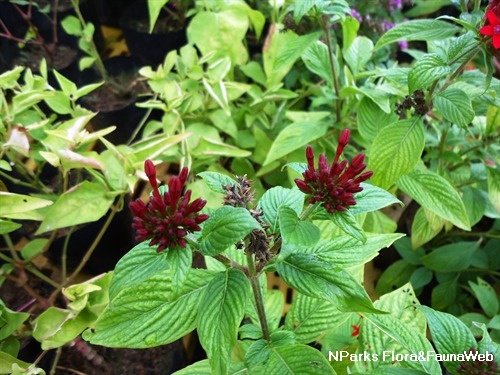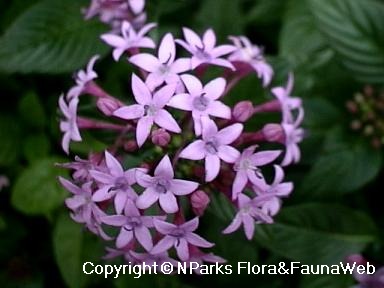.jpg)
Back
Pentas lanceolata (Forssk.) Deflers
| Family Name: | Rubiaceae |
| Synonyms: | Manettia lanceolata, Pseudomussaenda lanceolata, Ophiorrhiza lanceolata |
| Common Name: | Egyptian Star-cluster, Star-cluster, Maids-of-all-work, Egyptian Star |
Pentas lanceolata or commonly known as Egyptian Star-cluster is a native perennial from tropical East Africa to Southern Arabia that boasts clusters (corymbs) of striking bright red star-shaped flowers and dark green elliptic leaves.It is an attractive ornamental suitable for growing in mass for flowerbeds, or container planting and as houseplant, and attracts butterflies!
Name
Classifications and Characteristics
| Plant Division | Angiosperms (Flowering Seed Plants) |
|---|---|
| Plant Growth Form | Shrub |
| Lifespan (in Singapore) | Perennial |
| Mode of Nutrition | Autotrophic |
| Plant Shape | Shrubby |
| Maximum Height | 30 cm to 60 cm |
Biogeography
| Native Distribution | Tropical East Africa to Southern Arabia |
|---|---|
| Native Habitat | Terrestrial |
| Preferred Climate Zone | Tropical |
| Local Conservation Status | Non-native (Horticultural / Cultivated Only) |
Description and Ethnobotany
| Growth Form | Perennial shrub |
|---|---|
| Foliage | Dark green, opposite leaves are narrowly ovate to lanceolate with entire leaf margin (8 - 14 cm long). Leaves are deeply veined and pubescent (hairy). |
| Flowers | Star-shaped, 5-petalled flowers are 1 - 1.5 cm wide and occur in large terminal clusters known as corymbs. This species is free-flowering. |
| Fruit | Dry, dehiscent fruits are known as capsules (4 - 5 mm long). |
| Associated Fauna | This species is a butterfly nectar plant. |
| Cultivation | Easy to grow and should be planted in fertile, well-drained soil that is enriched with compost and organic matter to retain soil moisture. Allow the soil to dry slightly before re-watering. This cultivar blooms best when grown in full sun, but it also flowers in shade. This plant is heat tolerant. Feed plants every month with a balanced fertilizer at half-strength. To propagate by seed, sow the seeds on the soil surface and germination will occur in 5 - 12 days. |
| Etymology | The genus "Pentas" is derived from a Greek word that means 5 ("pente"). It may refer to the 5-petalled flowers that occur in this genus. The species epithet "lanceolata" refers to the lanceolate (lance-shaped) leaves. |
Landscaping Features
| Desirable Plant Features | Ornamental Flowers |
|---|---|
| Landscape Uses | Parks & Gardens, Small Gardens, Container Planting, Flowerbed / Border |
| Thematic Landscaping | Butterfly Garden |
Fauna, Pollination and Dispersal
| Fauna Pollination Dispersal Associated Fauna | Butterfly-Attracting |
|---|---|
| Pollination Method(s) | Biotic (Fauna) |
Plant Care and Propagation
| Light Preference | Full Sun, Semi-Shade |
|---|---|
| Water Preference | Moderate Water |
| Plant Growth Rate | Fast to Moderate |
| Rootzone Tolerance | Moist Soils, Well-Drained Soils |
| Transplanting Tolerance | Moderate |
| Maintenance Requirements | Low |
| Propagation Method | Seed, Stem Cutting |
| Planting Distance | 50 |
Foliar
| Foliage Retention | Evergreen |
|---|---|
| Mature Foliage Colour(s) | Green |
| Mature Foliage Texture(s) | Raised / Sunken Veins |
| Prominent Young Flush Colour(s) | Green |
| Young Flush Texture(s) | Raised / Sunken Veins |
| Foliar Type | Simple / Unifoliate |
| Foliar Arrangement Along Stem | Opposite |
| Foliar Attachment to Stem | Petiolate |
| Foliar Shape(s) | Non-Palm Foliage (Elliptical) |
| Foliar Venation | Pinnate / Net |
| Foliar Margin | Entire |
| Foliar Apex - Tip | Acute |
| Foliar Base | Acute |
Non - Foliar and Storage
| Stem Type & Modification | Woody |
|---|---|
| Root Type | Underground |
Floral (Angiosperm)
| Flower & Plant Sexuality | Bisexual Flowers |
| Flower Colour(s) | Red |
|---|---|
| Flower Texture(s) | Smooth |
| Flower Grouping | Cluster / Inflorescence |
| Flower Location | Terminal |
| Flower Symmetry | Radial |
| Individual Flower Shape | Stellate / Star-shaped |
| Inflorescence Type | Corymb |
| Flowering Period | Free-Flowering |
| Flowering Habit | Polycarpic |
Image Repository
Others
| Master ID | 1940 |
|---|---|
| Species ID | 3232 |
| Flora Disclaimer | The information in this website has been compiled from reliable sources, such as reference works on medicinal plants. It is not a substitute for medical advice or treatment and NParks does not purport to provide any medical advice. Readers should always consult his/her physician before using or consuming a plant for medicinal purposes. |







.jpg)

